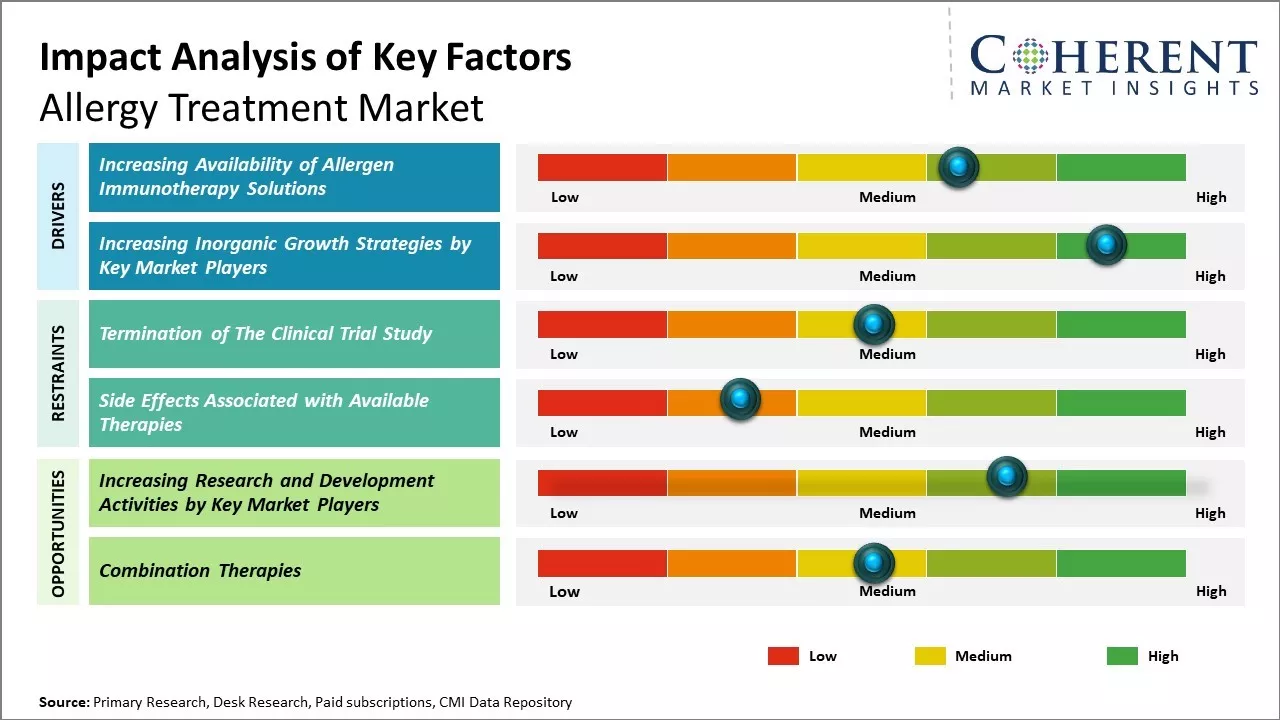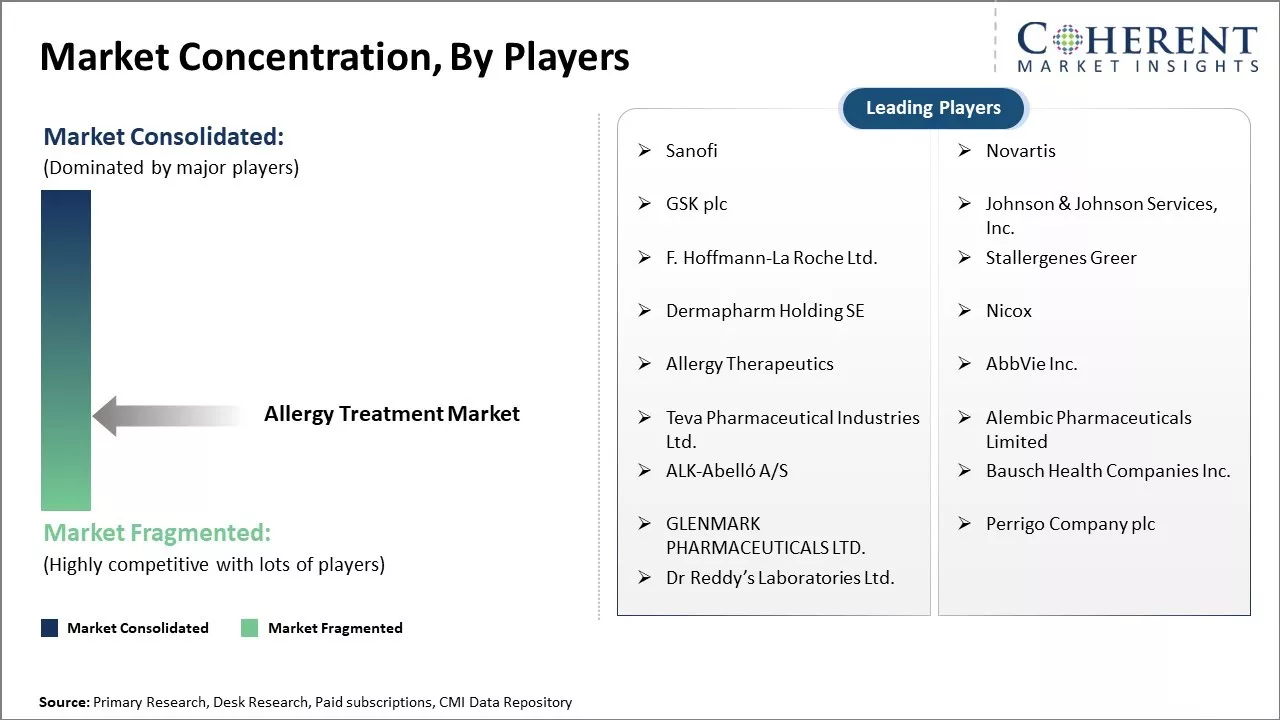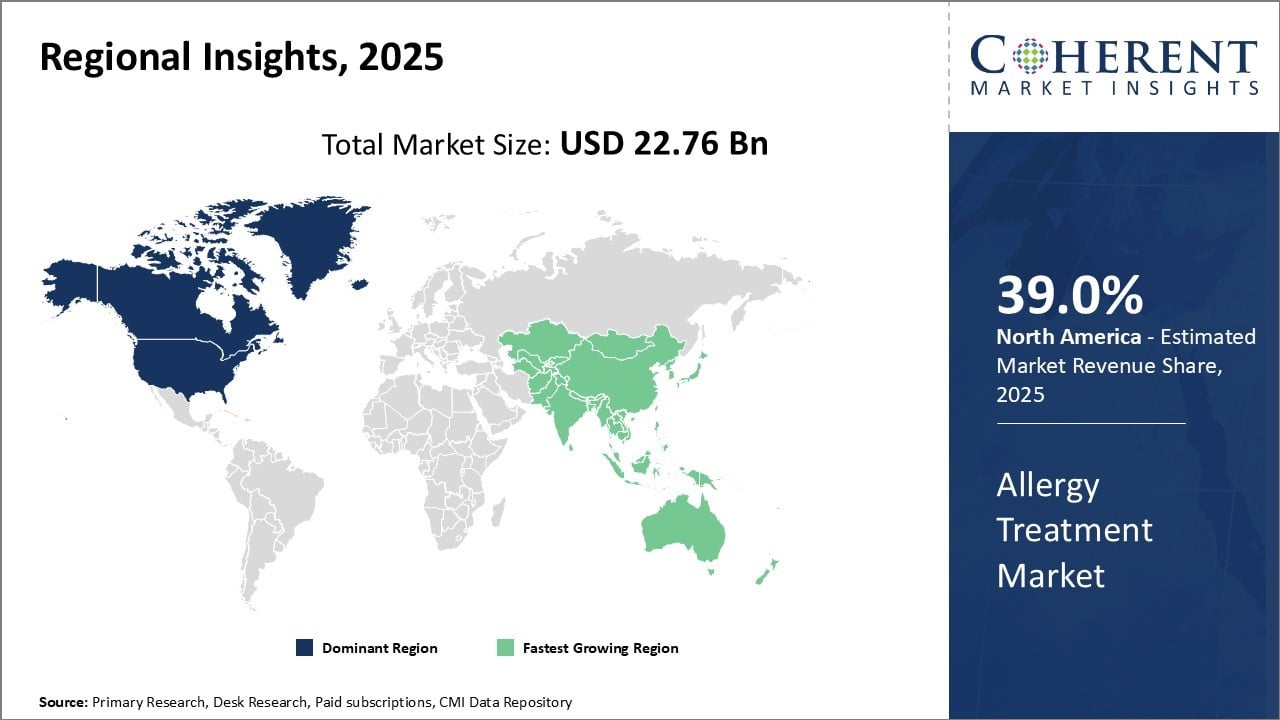The global allergy treatment market size is estimated to be valued at USD 22.76 Bn in 2025 and is expected to reach USD 37.54 Bn by 2032, exhibiting a compound annual growth rate (CAGR) of 7.4% from 2025 to 2032.

To learn more about this report, Download Free Sample
The global allergy treatment market trends indicate positive growth, with rising environmental pollution levels and growing adoption of sedentary lifestyle among people worldwide. Increased air pollution along with higher consumption of fast food and processed food has significantly contributed to the increased prevalence of allergies.
|
Event |
Description and Impact |
|
Technological Innovations in Allergy Treatment |
|
|
Climate Change and Environmental Shifts |
|
|
Regulatory Changes and Drug Approval Processes |
|
Uncover macros and micros vetted on 75+ parameters: Get instant access to report
The allergy treatment pipeline is expanding rapidly, driven by biologics, novel immunotherapies, and microbiome-based approaches. In Phase III, omalizumab (Xolair, Genentech/Novartis) and ligelizumab (Novartis) are advancing in food and chronic urticaria trials, leveraging IgE blockade for faster symptom control. Dupilumab (Sanofi/Regeneron) leads in Phase II for peanut and seasonal allergies, while etokimab and lirentelimab show promise for eosinophilic and IL-33-related pathways.
Phase I agents include LP-003 (LongBio) for allergic rhinitis and INI-2004 (Inimmune), a TLR4 agonist for mucosal immunotherapy. Emerging biologics such as TQC2731 (anti-TSLP) and PF-06817024 (anti-IL-33) target chronic respiratory allergies.
In preclinical and early-phase stages, Alladapt’s ADP101 and Camallergy’s botanical peanut therapy explore multi-allergen desensitization. Vedanta’s VE416 is pioneering gut-microbiome modulation for long-term food allergy tolerance. Key platforms include anti-cytokine antibodies, oral immunotherapy combos, and microbiome therapies.
Major trends include IgE-biologic and OIT synergy, non-steroidal pathways, and pediatric-friendly formulations. Regulatory bodies like FDA and EMA are accelerating reviews of innovative food allergy drugs, supporting the shift toward precision and durable allergy care.
The allergy treatment market research exhibits a dynamic patent landscape, with over 70% of active patents held by leading pharmaceutical companies such as Sanofi, Novartis, Regeneron, Genentech, and GSK. Key innovation areas include monoclonal antibodies targeting IgE, IL-4, IL-5, IL-13, and TSLP pathways, as well as novel oral immunotherapy (OIT) formulations and delivery systems.
Recent patent activity shows strong momentum in biologics, particularly anti-IgE and anti-cytokine therapies, combination treatments with immunotherapy, and next-gen sublingual and epicutaneous platforms. Patents on microbiome-modulating therapies and desensitization regimens are also on the rise, signaling a shift toward durable and preventive allergy solutions.
The U.S. and Europe dominate allergy-related patent filings, with growing contributions from China and South Korea, reflecting global R&D expansion. The competitive IP environment is fostering strategic alliances, pipeline diversification, and raising barriers to entry across the allergy biologics and immunotherapy segments.
The global reimbursement landscape for allergy treatment is complex and varies by therapy type, country, and payer structure. In the U.S., coverage for allergy medications and immunotherapy is guided by CPT and HCPCS codes. Medicare reimburses for physician-administered therapies like subcutaneous immunotherapy (SCIT) under Part B, with typical payments of $12–$18 per injection. Oral antihistamines and corticosteroids fall under Part D, with formulary inclusion varying by plan.
Medicaid programs cover basic allergy medications but often exclude advanced biologics like omalizumab unless medically necessary. Commercial insurers such as Aetna and Cigna reimburse 100–150% of Medicare rates for covered biologics but require prior authorization, step therapy, and allergy testing documentation.
Allergy treatment strategies vary widely among prescribers based on allergy type, severity, patient age, and response to prior therapies. For mild seasonal allergic rhinitis, primary care physicians and pediatricians typically recommend second-generation oral antihistamines like cetirizine or loratadine due to their non-sedating profiles and over-the-counter availability. Intranasal corticosteroids such as fluticasone or mometasone are preferred for persistent symptoms.
In moderate-to-severe cases, allergists often escalate to leukotriene receptor antagonists (e.g., montelukast) or prescribe subcutaneous immunotherapy (SCIT) for long-term desensitization. Sublingual immunotherapy (SLIT) tablets are favored in Europe and among pediatric patients for dust mite and grass pollen allergies due to ease of use and better adherence.

To learn more about this report, Download Free Sample
The increasing availability of allergen immunotherapy solutions is one of the factors that is expected to drive the market growth during the forecast period. For instance, in June 2021, Stallergenes Greer, one of the global leaders in allergy immunotherapy, announced that the Alusta, subcutaneous allergen immunotherapy (SCIT) solution for different allergies involving rhinitis, conjunctivitis, rhino conjunctivitis, or asthma is now available in Spain and Italy.
Increasing adoption of inorganic growth strategies, such as collaborations, is expected to drive the market growth over the forecast period. For instance, on January 8, 2024, Inimmune Corporation, a pharmaceutical company, and Intrommune Therapeutics, Inc., a clinical-stage company focused on the development of innovative immunotherapeutics, announced that they had collaborated together to advance a revolutionary rapid, long-acting oral mucosal allergy immunotherapy for the treatment of peanut allergy.
The major factors that are expected to hinder the growth of the global allergy treatment market include the termination of clinical trial study. For instance, in November 2022, a clinical trial of Tree MATA MPL or Tree MATA immunotherapy for allergic rhinitis and type I hypersensitivity I was terminated due to the poor enrollment of subjects. The clinical trial was sponsored by Allergy Therapeutics, a manufacturer of subcutaneous and sublingual immunotherapy treatments.
Increasing research and development activities by market players is expected to offer lucrative growth opportunities over the forecast period. For instance, in August 2023, Inimmune Corporation (“Inimmune”), a clinical-stage company focused on the development of innovative immunotherapeutics, announced that the first subject has been dosed in Inimmune’s phase 1/1b First-in-Human clinical trial of INI-2004, Inimmune’s TLR4 agonist product candidate under development as a potential treatment of allergic rhinitis.
The phase 1/1b trial is a randomized, double-blind, placebo-controlled, dose-escalating study to evaluate the safety, tolerability, pharmacokinetics, and pharmacodynamics of INI-2004 in healthy volunteers and participants with allergic rhinitis (AR).
The type segment includes eye allergy, asthma, rhinitis, skin allergy, food allergies, and others. The asthma sub-segment is estimated to hold 32.2% of the market share in 2025 owing to the rising prevalence of asthma globally. According to recent estimates by health organizations, over 300 million people suffer from asthma worldwide. The condition is characterized by inflammation of the airways and difficulty in breathing.
Conventional treatment of acute asthma involves the use of short-acting beta-agonists to relax bronchial muscles. However, long-term control medications such as inhaled corticosteroids and leukotriene modifiers are essential to prevent recurrent symptoms. The asthma segment is driven by the need for more effective medicines that can better manage symptoms over prolonged use. Several drug makers are investing in research to develop novel biologic drugs targeting specific inflammatory pathways involved in asthma pathophysiology.
Monoclonal antibody therapies that block immune system proteins like IgE and IL-5 have shown promising results in clinical trials. Such targeted drugs offer superior efficacy with less risk of side effects compared to existing options. Their approval and commercialization in major markets will provide a significant boost to the asthma segment in the coming years.
The treatment segment includes anti-allergy drugs and immunotherapy. The anti-allergy drugs sub-segment is estimated to hold 82.9% of the market share in 2025 owing to their widespread adoption for treating different types of allergies. Allergic disorders often require long-term pharmacological intervention to control symptoms.
Drugs from several classes like antihistamines, decongestants, leukotriene inhibitors, and mast cell stabilizers form the mainstay of treatment. Allergy treatment in eye irritation often involves oral antihistamines, which are among the most commonly used medications worldwide for relieving symptoms like sneezing, itchy eyes, and nose.
The segment sees major growth due to the continuous development and approval of novel anti-allergy drugs with improved safety profiles. For example, newer generation non-sedating antihistamines have gained popularity as they cause fewer drowsiness side effects than older formulations.
Also, combination therapies that incorporate other classes of drugs into a single medication provide better symptom relief with just one intake. Self-administration of oral drugs also adds to convenience compared to other modes like allergen immunotherapy requiring periodic physician supervision. These factors consolidate the leading position of anti-allergy drugs in the treatment segment.
The distribution channel segment includes hospital pharmacies, retail pharmacies, and online pharmacies. The hospital pharmacies sub-segment is estimated to hold 34.7% of the market share in 2025 owing to their increasing role beyond mere drug dispensing. Hospitals function as the frontline contact point for many patients experiencing exacerbation of allergic conditions. Severe cases often necessitate in-patient admission and administration of specialized drugs through the intravenous route under medical supervision.
The segment is witnessing strong growth aided by hospital pharmacies expanding their service portfolio to include outsourced compounding of personalized medications, allergy testing facilities and patient education programs. This enhances accessibility to specialized care and strengthens adherence to long-term drug regimens. The shift towards value-based care is also driving many health systems to invest more resources in establishing comprehensive allergy centers and specialty clinics within their hospital pharmacy divisions.
This allows for streamlined delivery of multi-disciplinary services from diagnosis to ongoing treatment under a single umbrella. Holistic allergy treatment approaches optimize outcomes for allergic patients while boosting pharmacy revenues. These favorable trends fuel the prominence of hospital pharmacies as the leading distribution network.

To learn more about this report, Download Free Sample
North America remains the dominant region in the global allergy treatment market and is estimated to hold 39.0% of the market share in 2025. Strong uptake of allergy immunotherapy and the wide availability of generic drugs have supported market growth. The region is home to most leading global pharmaceutical companies with large allergy portfolios.
These companies carry out extensive R&D activities and frequently introduce new products, ensuring patients have access to the latest treatment options. Additionally, high awareness regarding allergies and their management has eased treatment-seeking behavior. However, price controls pose pricing challenges, pushing manufacturers to offer value-based offerings.
Asia Pacific is expected to record the highest growth, led by China, India and other developing nations. This can be attributed to improving healthcare infrastructure, rapid economic expansion, and growing medical tourism in these countries. Greater exposure to pollutants and changing lifestyles have contributed to rising allergy prevalence.
Local manufacturers are strengthening their generic drug production to meet the needs of price-sensitive consumers. Over-the-counter drugs are also more accessible due to lenient regulations. This has boosted self-medication and made first-line therapies more affordable. International players are focusing on these emerging markets by tying up with local partners or setting up own manufacturing facilities. They view it as a high-potential region to tap into future demand.
| Report Coverage | Details | ||
|---|---|---|---|
| Base Year: | 2024 | Market Size in 2025: | USD 22.76 Bn |
| Historical Data for: | 2020 To 2024 | Forecast Period: | 2025 To 2032 |
| Forecast Period 2025 to 2032 CAGR: | 7.4% | 2032 Value Projection: | USD 37.54 Bn |
| Geographies covered: |
|
||
| Segments covered: |
|
||
| Companies covered: |
Sanofi, Novartis, GSK plc, Johnson & Johnson Services, Inc., F. Hoffmann-La Roche Ltd., Stallergenes Greer, Dermapharm Holding SE, Nicox, Allergy Therapeutics, AbbVie Inc., Teva Pharmaceutical Industries Ltd., Alembic Pharmaceuticals Limited, ALK-Abelló A/S, Bausch Health Companies Inc., GLENMARK PHARMACEUTICALS LTD., Perrigo Company plc, and Dr Reddy’s Laboratories Ltd. |
||
| Growth Drivers: |
|
||
| Restraints & Challenges: |
|
||
Uncover macros and micros vetted on 75+ parameters: Get instant access to report
*Definition: An allergy is a reaction by the immune system to something that does not bother most other people. An allergy occurs when a person reacts to substances n the environment that are harmless to most people. The allergy treatment market with dust mite allergies includes substances known as allergens, commonly found in pollen, pets, insects, mold, ticks, foods, some drugs, and particularly dust mites. Allergy symptoms rage from mild rash to hive, runny nose, itchiness, and watery red eyes, to life threatening.
Share
Share
About Author
Ghanshyam Shrivastava - With over 20 years of experience in the management consulting and research, Ghanshyam Shrivastava serves as a Principal Consultant, bringing extensive expertise in biologics and biosimilars. His primary expertise lies in areas such as market entry and expansion strategy, competitive intelligence, and strategic transformation across diversified portfolio of various drugs used for different therapeutic category and APIs. He excels at identifying key challenges faced by clients and providing robust solutions to enhance their strategic decision-making capabilities. His comprehensive understanding of the market ensures valuable contributions to research reports and business decisions.
Ghanshyam is a sought-after speaker at industry conferences and contributes to various publications on pharma industry.
Missing comfort of reading report in your local language? Find your preferred language :
Transform your Strategy with Exclusive Trending Reports :
Frequently Asked Questions
Joining thousands of companies around the world committed to making the Excellent Business Solutions.
View All Our Clients